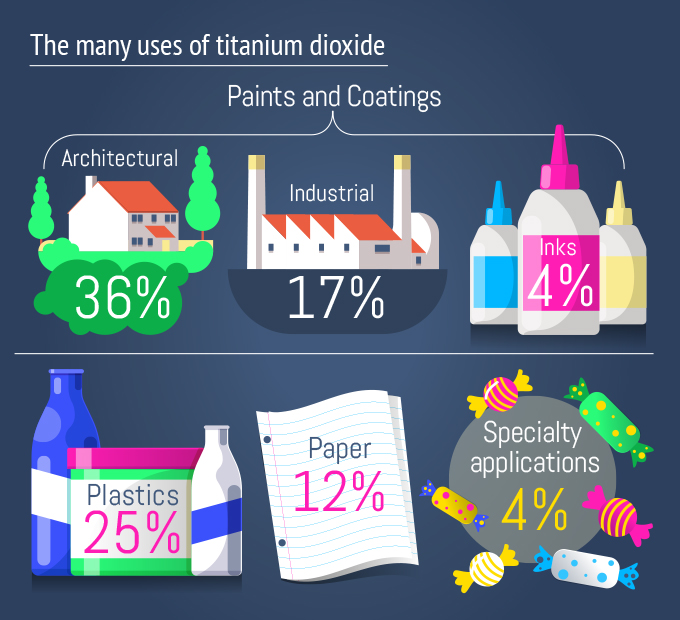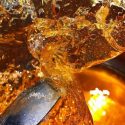What Is Titanium Dioxide (E171) In Food And Why Is It In Sunscreen?

Two types | Production | Uses | Safety | Side effects | FAQs
Titanium dioxide (TiO2), the naturally occurring oxide of titanium which generally comes from rutile & anatase. It is the most widely used white food coloring, and also finds application in cosmetics, paints and coatings for its brightness, opaqueness and high refractive index (ability to scatter light). When used in food, TiO2 is safe, natural, vegan, halal, kosher and gluten-free with the European food additive number E171.
Two Types of Titanium Dioxide
Generally, there are two grades of TiO2, pigment grade and nano grade according to its different particle sizes and the corresponding uses. It can also be classified into rutile and anatase grade based on the sources.
Difference between Pigment Grade and Nano Grade
The pigment grade is also known as titanium white, pigment white 6 or CI 77891, it is the whitest and brightest of all known pigments and most used in food, paints and coatings.
The nano-sized (particle size less than 100nm), which is transparent rather than white, with improved ability in scattering and absorbing ultraviolet light than pigment grade. Its main uses are in cosmetics and also as a photocatalyst in specified industries.
Photocatalyst
TiO2 nanoparticles have photocatalytic characteristics in exhibiting oxidation-reducing properties under exposure to UV radiation by coatings of metals, compound semiconductors, inorganic chemicals and so on, which can be utilized to decompose environmental pollutants, such as for air and water purification.
How is Titanium dioxide Made?
TiO2 naturally exists in different crystalline forms, anatase and rutile are the two most common and commercial forms. TiO2 produced from anatase is a white powder, while from rutile is off-white and may exhibit a slight color.
It may be coated with small amounts of alumina and/or silica to improve the technological properties of the product. (1)
Commercial titanium dioxide pigment is generally produced by either the sulfate or chloride process. The main raw materials include ilmenite (iron titanium oxide, FeO / TiO2 or FeTiO3), natural rutile and titanium slag.
The sulfate method is the earlier method but due to environmental and cost issues, the chloride process is currently preferred by the manufacturers.
Sulfate process
Titanium dioxide in titanium slag, anatase and rutile can be refined by the sulfate method.
From Titanium Slag
The manufacturing process as follows:
- Dissolving titanium-containing slag with sulfuric acid and then diluted with water or dilute acid.
- Most of the solubilized titanium dioxide from the ore is in the form of titanium oxysulfate, and iron ions exhibit in its divalent oxidation form, which can be filtered and removed by crystallization to form ferrous sulfate (FeSO4 · 7H2O).
- Other impurities like silica are removed by sedimentation.
- TiO2 is obtained by hydrolysis of titanyl oxysulfate.
- Washed with water, calcined and micronized.
Here is the reaction equation:
- FeTiO3+H2SO4=TiOSO4+FeSO4+2H2O
- TiOSO4+2H2O=TiO2·H2O+H2SO4
From Anatase and Rutile
To extract titanium dioxide in anatase and rutile, part of the clarified liquid needs to be neutralized with alkali in order to produce anatase microcrystals. Then put these microcrystals back to the reaction for hydrolysis to generate anatase crystals.
Finally, washed with water, calcined and micronized at 800-850 °C (for anatase) or 900-930 °C (for rutile). (2)
Chloride process
There are common two flow charts as follows:
The reaction between chlorine and rutile in a fluidized bed reactor at a high temperature of 800-1200 °C, and rutile is converted to titanium tetrachloride anhydrous under reducing conditions.
Titanium tetrachloride is transformed into titanium dioxide after purification and goes through a high-temperature oxidation method OR reacting with water vapor at a high temperature of 900-1400 °C. Finally, washed, calcined and micronized.
Here is the reaction equation:
TiCl4+O2=TiO2+2Cl2 OR TiCl4+H2O=TiO2+HCl
Alternatively, the titanium-containing ore reacts with a certain concentration of chloride to form a titanium tetrachloride aqueous solution, which is then further purified, crushed, filtered, washed, calcined and subsequently reactions to obtain the final product.
Titanium dioxide/platelet form
The platelet form is manufactured by coating mica (also known as potassium aluminum silicate) with titanium dioxide (rutile).
Specification
| Appearance | White to slightly coloured powder. Tasteless, non-flammable, stable and doesn’t react with other chemicals. |
| Other names |
|
| CAS number | 13463-67-7 |
| Chemical formula | TiO2 |
| Molecular weight | 79.88 |
| Particle Size | Food grade is not nanomaterial, it is mainly composed of particles greater than 100 nm, but a small fraction of nanoparticles(< 100 nm) exists. |
| Solubility | Insoluble in water and organic solvents. TiO2 aggregates in aqueous media. |
| Melting Point | 1843ºC |
| Boiling point | 2972ºC |
What are the Uses of Titanium dioxide?
Titanium dioxide is the most widely used colorant in food, personal care, paints, coatings, paper, plastics, paper, inks and fibers because of its brightening and whitening properties. The rapid development of nano-sized titanium dioxide in sunscreen also can be witnessed.

Image Source
Food coloring
Titanium dioxide is a multi-purpose ingredient that can be used as a color, drying agent, anticaking agent, humectant, nutrient supplement and surface-finishing agent in food. (3)
Its primary use is as white color to impart the whiteness and brightness effect in food processing. It is a common additive that makes food look brighter and more appealing to eat.
The following food may with titanium dioxide:
- Milk
- Coffee creamers
- Salad dressing
- Candies, chocolate, sweets and chewing gums
- Snacks
- Sauce
- Vitamin supplements
Medicines
It can be used as a color additive for drugs and can be combined with silicon dioxide, and/or aluminum oxide as diluents (4). It is used to add whiteness and also acts as a protective coating to preserve the active ingredient in pharmaceutical tablets and capsules.
Cosmetics
Titanium dioxide functions as a cosmetic colorant, opacifying, UV absorber, and UV filter in cosmetic and personal care products (5). FDA claimed the color additive titanium dioxide may be safely used in cosmetics and cosmetics for the eye. (6)
Following cosmetics may contain titanium dioxide:
- Foundations
- Eye shadows
- Lipsticks
- Makeup powder
- Creams
- Lotions
- Shampoo
A White Color
Titanium dioxide has two functions in cosmetics. The pigment grade can be used as a decorative for its white and bright color. Cosmetic manufacturers use this ingredient to create various shades in mineral makeup foundations and lipsticks to suit all skin types.
UVA and UVB Block
Also, it has some functions in protecting the skin from sunburn and premature aging due to harmful ultraviolet radiation. Its nanopowder (also called micronized titanium dioxide), a very fine powder, no longer gives the product a white color, but has a strong effect in defending UVA and UVB compared with the pigment grade and used widely in suncare products.
Advantages over Chemical absorbers
In sunscreen cosmetics, nano tio2 is used as a physical way to defend against UVA and UVB by scattering and absorbing ultraviolet rays while the common method to absorb ultraviolet rays is using chemicals.
Common chemically synthesized UV absorbers are as follows:
- UVA absorbers: oxybenzone, menthyl anthranilate, and dibenzoylmethane.
- UVB absorbers: methoxycinnamate Ester (OMC), 4-methylbenzylidene camphor (MBC).
However, these chemical ingredients in sunscreens are irritating, poor light stability, and are easy to decompose. At the same time, they can cause skin allergies, inflammation and other side effects.
What are UVA, UVB and UVC?
Ultraviolet rays refer to rays with a wavelength of 200 to 400nm, which is the shortest wavelength of the sun’s rays. Ultraviolet rays can be divided into three wavelengths: long-wave ultraviolet (UVA), medium-wave ultraviolet (UVB) and short-wave ultraviolet (UVC).
UVC (100–280nm)
It can be absorbed by the ozone layer and cannot reach the ground, so it has no side effect on the human body.
UVB (280–315nm)
It takes a very little part of the total ultraviolet radiation that reaches the ground, mostly absorbed by the dermis of the skin, causing dermal blood vessels to dilate, with the symptoms of redness, swelling, and blisters.
Long-term exposure to UVB can cause skin erythema, inflammation, skin aging, freckles, moles and severely even skin cancer. The value of SPF (sun protection factor for the UVB) is around 2.5 of 1% micronized titanium dioxide, it is more effective in blocking UVB compared with zinc dioxide, the SPF value of which is 1.5. (7)
UVA (315–400nm)
It shares more than 95% of the total ultraviolet radiation that reaches the ground (8). Although UVA does not cause acute inflammation to the skin, long-term accumulation will lead to melanin deposits, skin discoloration, wrinkles and may even cancer.
Nano titanium dioxide also blocks UVA rays, but less effective than zinc dioxide. Nanoparticles of titanium dioxide and zinc oxide are always used together in sunscreen and sunblock to defend against both UVA and UVB.
Toothpaste
Its purpose is to whiten toothpaste and give it a more appealing appearance. “Sparkling Mint Gel” toothpaste of Colgate are colored with titanium dioxide (coated mica). (9)
There is a misunderstanding that titanium dioxide in toothpaste is used as a detergent.
Paints and Coatings
In paints, titanium dioxide is mainly used as a white pigment and other white pigments cannot compete with its opacity. It is not only used in white paints, also added for rich color effects by coloring shades. For example, it can be used in the following common paints applications:
- Latex paints
- Anticorrosive paints
- Furniture paints
- Traffic paints
- Container paints
- Auto paints
It is said in TDMA’s website that more than 90% of paints and coatings contain titanium dioxide. (10)
Soap
Titanium dioxide is commonly used to enhance the color from grey or cream to white, or to lighten other colors in soap making.
Is Titanium Dioxide Food Grade Safe to Eat?
Yes, it is edible and has been approved as a safe ingredient by the U.S. Food and Drug Administration (FDA) and the European Food Safety Authority (EFSA), as well as the Joint FAO/WHO Expert Committee on Food Additives (JECFA).
FDA
Titanium dioxide may be safely used for coloring foods with the maximum use levels not exceeding 1% of the food. (11)
TiO2-coated mica-based pearlescent pigments can also be used as a colour additive in food. (12)
EFSA
Titanium dioxide (E171) is listed in Commission Regulation (EU) No 231/2012 as an authorised food additive in both anatase and rutile grades and categorized in “colours” with the maximum usage “quantum satis” (13).
Safety Re-evaluation in 2016
The absorption of oral dose of TiO2 is extremely low and the vast majority of it is eliminated unchanged in the faeces and only a small amount (maximum of 0.1%) is absorbed by the gut and distributed to various organs.
After the studies on genotoxicity and carcinogenicity and other researches, EFSA concluded that it is safe to use TiO2 as a food additive. EFSA also noticed that its non-food grade (nano titanium dioxide) may cause possible adverse effects in the reproductive system of mice and rats. (14)
Evaluation of New Studies of Toxicity in 2018
EFSA concluded that four studies which claimed TiO2 could cause the the health risk of carcinogenicity, genotoxicity and other problems are not solid proof or it was the nanomaterial which was dangerous instead of its food grade. (15)
Approved uses
This food color is approved to use in food widely and the following food may contain it:
- Flavoured fermented milk products, dehydrated milk
- Flavoured unripened(processed) cheese, edible cheese rind, whey cheese, beverage whiteners, edible ices
- Confectionery, chewing gum, decorations, coatings and fillings
- Breakfast cereals, Potato-, cereal-, flour- or starch-based snacks, processed nuts
- Noodles, batters, fine bakery wares
- Casings and coatings and decorations for meat
- Seasonings, mustard, soups and broths
- Flavored drinks
- Seaweed based fish roe analogues
- Fish paste and crustacean paste
- Smoked fish
UK Food Standards Agency
Categorized in “Others” (16)
Food Standards Australia New Zealand
It is an approved ingredient in Australia and New Zealand with the code number 171. (17)
JECFA
Function Class: food additives, colour. (18)
Acceptable daily intake: ADI “not limited” set in 1969. (19)
What are the Possible Side Effects of Titanium dioxide?
Some people have concerns about the safety of Titanium dioxide because there have been a lot of reports for its cancer causing problem. It is either safe or unsafe based on the nanoparticle size and the applications. The food grade has no side effects but the nanoparticle size less than 10 μm will do bad to our health as it is a carcinogen.
Is Titanium Dioxide in Vitamin Supplements Safe?
Yes, it is safe when used in vitamin supplements. Consumers are afraid that the additive in paints is also used for food supplements. But please be assured when used in food, it works as a mineral whitener of its food grade instead of the nanoparticle, which is not permitted to use in food.
Why and What Conditions Does Titanium Dioxide Cause Cancer?
Food grade (non nano) is safe by ingestion while the nano grade may cause cancer by inhalation.
Proposition 65
According to the information of Proposition 65 Warnings, types of titanium dioxide whose particle size measuring 10 micrometers or less are on the Proposition 65 list as it can be inhaled and may increase the risk of cancer. Such microscopic particles may be present in spray-on (aerosolized) sunscreens, hair color sprays, and cosmetic powders. (20)
Category 2 carcinogen
Furthermore, in 2020, the European Union classified titanium dioxide (TiO2) in powder form containing 1 % or more of particles below 10 μm as a category 2 carcinogen by inhalation under EU Regulation (EC) No 1272/2008 on classification, labelling and packaging of substances and mixtures as the inhalation of respirable titanium dioxide particles is associated with lung carcinogenicity. (21)
What’re the Allergies symptoms Titanium Dioxide may Cause?
In the safe re-evaluation in 2016, EFSA concluded that it was the high doses of nanosized TiO2 that affected the immune system that caused the instead of the food grade TiO2, in most of the published studies.
Is Titanium Dioxide Safe During Pregnancy?
Foods with it are safe for pregnant women. TiO2 in cosmetics (such as sunscreens) is also safe if less than 1 % of its particles below 10 μm.
Frequently Asked Questions
Is Titanium dioxide Vegan?
Yes, TiO2 is vegan as it does not contain animal-derived components in the synthesis and final products. So suitable to add in the diet of vegetarians.
Is Titanium Dioxide Gluten-free?
Yes, it is gluten free as it does not contain wheat, rye, barley, or crossbreeds of these grains. And it is generally considered safe for people with celiac disease.
What Is Titanium Dioxide Made Of?
TiO2 may also contain a very small amount of other minerals, such as calcium and iron.
Does Titanium Dioxide Clog Pores in Sunscreens?
No, it is noncomedogenic, which is said in Forbes. (22)
What Are Alternatives to Titanium Dioxide in food?
Ingredients that can be used in place of TiO2 in some food applications such as silica dioxide and calcium phosphate.
How To Dissolve Titanium Dioxide?
As TiO2 is not soluble in water and organic solvents, it can be dispersed before use, such as in food oils, propylene glycol, sugar syrup, or water with thickeners. (23)
Conclusion
Now I think you may have a good knowledge of the food coloring – titanium dioxide (E171), from the following aspects:
- Two types: pigment and nano grade
- Two production process: sulfate and chloride process
- Uses: in food, cosmetics, medicines, paints & coating and so on
- Food grade Safety
- Possible side effects of its nanoparticles
- Comparison and used together with zinc dioxide in cosmetics
- FAQs
What other products have you found this ingredient in? Let me know in the comments.


No, it is not safe, it is linked to colorectal cancer and it has already been banned in France.
This article was written in 2020 and is out of date. Titanium dioxide was banned in Europe in 2022.
Subsequent to the publication of this article in 2020, titanium dioxide was disallowed by the European Food Safety Authority (EFSA) for use as a food additive in Europe in 2022. See https://www.efsa.europa.eu/en/news/titanium-dioxide-e171-no-longer-considered-safe-when-used-food-additive
Thanks